Direct Sequence Transmission
Direct sequence transmission is an alternative spread-spectrum technique that can be used to transmit a signal over a much wider frequency band. The basic approach of direct-sequence techniques is to smear the RF energy over a wide band in a carefully controlled way. Changes in the radio carrier are present across a wide band, and receivers can perform correlation processes to look for changes. The basic high-level approach is shown in Figure 12-1.
Figure 12-1. Basic DSSS technique

At the left is a traditional narrowband radio signal. It is processed by a spreader, which applies a mathematical transform to take a narrowband input and flatten the amplitude across a relatively wide frequency band. To a narrowband receiver, the transmitted gnal looks like low-level noise because its RF energy is spread across a very wide band. The key to direct-sequence transmission is that any modulation of the RF carrier is also spread across the frequency band. Receivers can monitor a wide frequency band and look for changes that occur across the entire band. The original signal can be recovered with a correlator, which inverts the spreading process.
At a high level, a correlator simply looks for changes to the RF signal that occur across the entire frequency band. Correlation gives direct-sequence transmissions a great deal of protection against interference. Noise tends to take the form of relatively narrow pulses that, by definition, do not produce coherent effects across the entire frequency band. Therefore, the correlation function spreads out noise across the band, and the correlated signal shines through, as illustrated in Figure 12-2.
Figure 12-2. Spreading of noise by the correlation process

Direct-sequence modulation works by applying a chipping sequence to the data stream. A chip is a binary digit used by the spreading process. Bits are higher-level data, while chips are binary numbers used in the encoding process. There is no mathematical difference between a bit and a chip, but spread-spectrum developers have adopted this terminology to indicate that chips are only a part of the encoding and transmission process and do not carry any data. Chipping streams, which are also called pseudorandom noise codes (PN codes), must run at a much higher rate than the underlying data. (The requirement for high-speed oscillators to generate chip streams and recover data from chip streams is one of the major power drains in direct sequence PHYs.) Figure 12-3 illustrates how chipping sequences are used in the transmission of data using direct-sequence modulation. At the left-hand side is a single data bit, which is either a one or a zero. For each data bit, several chips are used. In the figure, the chip stream consists of an 11-bit code. It is combined with the single data bit, to produce 11 chips that carry the single data bit. The 11-chip/single-data-bit sequence is transmitted over the radio link and received at the other end. Every chunk of 11 chips is the compared to an identical chip stream. If it matches the spreading code, a single zero data bit is recovered; if not, a single one data bit is recovered.
The process of encoding a low bit-rate signal at a high chip rate has the side effect of spreading the signal's power over a much wider bandwidth. One of the most important quantities in a direct-sequence system is its spreading ratio, which is the number
Figure 12-3. Chipping

of chips used to transmit a single bit.[*] Higher spreading ratios improve the ability to recover the transmitted signal but require a higher chipping rate and a larger frequency band. Doubling the spreading ratio requires doubling the chipping rate and doubles the required bandwidth as well. There are two costs to increased chipping ratios. One is the direct cost of more expensive RF components operating at the higher frequency, and the other is an indirect cost in the amount of bandwidth required. Therefore, in designing direct-sequence systems for the real world, the spreading ratio should be as low as possible to meet design requirements and to avoid wasting bandwidth.
[*] The spreading ratio is related to a figure known as the processing gain. The two are sometimes used interchangeably, but the processing gain is slightly lower because it takes into account the effects of using real-world systems as opposed to perfect ideal systems with no losses.
Direct-sequence modulation trades bandwidth for throughput. Compared to traditional narrowband transmission, direct-sequence modulation requires significantly more radio spectrum and is much slower. However, it can often coexist with other interference sources because the receiver's correlation function effectively ignores narrowband noise. It is easier to achieve high throughput using direct-sequence techniques than with frequency hopping. Regulatory authorities do not impose a limit on the amount of spectrum that can be used; they generally set a minimum lower bound on the processing gain. Higher rates can be achieved with a wider band, though wider bands require a higher chip rate.
Encoding in 802.11 Direct Sequence Networks
For the PN code, 802.11 adopted an 11-bit Barker word. Each bit is encoded using the entire Barker word as a chipping sequence. Detailed discussion of Barker words and their properties are well beyond the scope of this book. The key attribute for 802.11 networks is that Barker words have good autocorrelation properties, which means that the correlation function at the receiver operates as expected in a wide range of environments and is relatively tolerant to multipath delay spreads. 11 bits are in the word because regulatory authorities often require a 10-dB processing gain in direct sequence systems. Using an 11-bit spreading code for each bit allows 802.11 to meet the regulatory requirements with some margin of safety, but it is small enough to allow as many overlapping networks as possible. Longer spreading codes allow higher processing gains but require wider frequency channels.
802.11 uses the Barker sequence {+1, -1, +1, +1, -1, +1, +1, +1, -1, -1, -1}. As used in 802.11, +1 becomes 1, and -1 becomes 0, so the Barker sequence becomes 10110111000. It is applied to each bit in the data stream by a modulo-2 adder.[*] When a 1 is encoded, all the bits in the spreading code change; for 0, they stay the same. Figure 12-4 shows the encoding process.
[*] Encoding with the Barker sequence is similar to a number of other techniques. Some cellular systems, most notably in North America, use code division multiple access (CDMA) to allow several stations to access the radio medium. CDMA exploits some extremely complex mathematics to ensure that transmissions from each mobile phone look like random noise to every other mobile phone in the cell. The underlying mathematics are far more complicated than a simple, fixed pseudorandom noise code.
Figure 12-4. Encoding with the Barker word
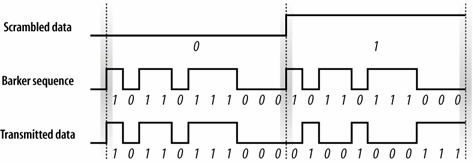
Receivers can look at the number of 1s in a received bit time. The Barker sequence has six 1s and five 0s. An 11-bit sequence with six 1s must therefore correspond to a transmitted 0, and an 11-bit sequence with six 0s must correspond to a transmitted 1. In addition to counting the numbers of 1s and 0s, the receiver can analyze the pattern of received bits to infer the value of the transmitted bit.
Radio Spectrum Usage in 802.11 Direct Sequence Networks
Channels for the DS PHY are much larger than the channels for the FH PHY. The DS PHY has 14 channels in the 2.4-GHz band, each 5 MHz wide. Channel 1 is placed at 2.412 GHz, channel 2 at 2.417 GHz, and so on up to channel 13 at 2.472 GHz. Channel 14 was defined especially for operation in Japan, and has a center frequency that is 12 MHz from the center frequency of channel 13. Table 12-1 shows which channels are allowed by each regulatory authority. Channel 10 is available throughout North America and Europe, which is why many products use channel 10 as the default operating channel.
|
Regulatory domain |
Allowed channels |
|---|---|
|
U.S. (FCC)/Canada (IC) |
1 to 11 (2.412-2.462 GHz) |
|
Europe, excluding Spain (ETSI) |
1 to 13 (2.412-2.472 GHz) |
|
Spain |
10 to 11 (2.457-2.462 GHz) |
|
Japan (MIC) |
1 to 13 (2.412-2.462 GHz) and 14 (2.484 GHz) |
Channel energy spread
Within a channel, most of the energy is spread across a 22-MHz band. Because the DS PHY uses an 11-MHz chip clock, energy spreads out from the channel center in multiples of 11 MHz, as shown in Figure 12-5. To prevent interference to adjacent channels, the first side lobe is filtered to 30 dB below the power at the channel center frequency, and additional lobes are filtered to 50 dB below the power at the channel center. This corresponds to reducing the power by a factor of 1,000 and 100,000, respectively. These limits are noted in Figure 12-5 by the use of dBr, which means dB relative to the power at the channel center. Figure 12-5 uses a logarithmic scale: -30 dBr is only one thousandth, and -50 dBr is one hundred thousandth.
Figure 12-5. Energy spread in a single 802.11 DS transmission channel
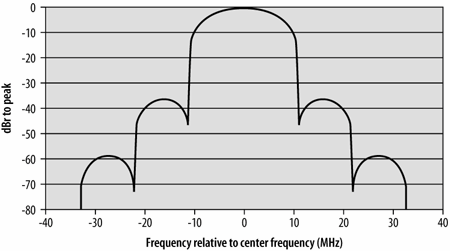
With the transmit filters in place, RF power is confined mostly to 22-MHz frequency bands. European regulators cap the maximum radiated power at 100 mW; the FCC in the U.S. allows a substantially higher transmission power of 1,000 mW. If directional antennas are used, the power can be concentrated into an even higher radiated power.
Adjacent channel rejection and channel separation
To avoid interference, 802.11 equipment must be separated in the frequency domain. The initial specification called for 35 dB rejection when two signals were 30 MHz apart, but the spectral separation was tightened up to 25 MHz in 802.11b. To measure adjacent channel rejection, input a maximum-speed signal at the center frequency of a channel, shown by the left curve in Figure 12-6. Its power is 6 dB above the specified minimum sensitivity; for an 802.11b receiver, that is -70 dBm. A second 802.11b signal at 11 Mbps is sent in, 35 dB stronger, but at least 25 MHz away. The right curve depicts the interference test signal. As long as the frame error rate is less than 8%, the receiver passes the test. Note that there is reasonably significant overlap between the first lobe of the interfering signal and the main center lobe of the on-channel signal.
Figure 12-6. Adjacent channel rejection
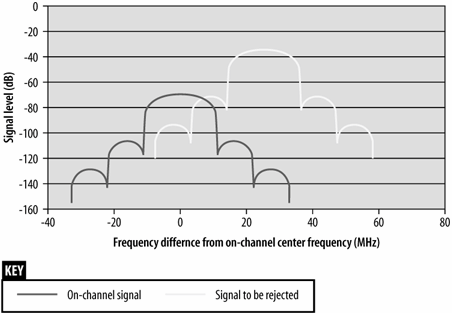
Adjacent channel rejection also influences the number of channels that can be used simultaneously. Although 802.11 networks operating in the ISM band have 14 defined channels, they are closely packed. Real signals must be spaced out to prevent interference. 802.11b specifies that a 25 MHz (5 channel number) spacing is sufficient. Figure 12-7 shows the spectral mask of transmissions on the so-called non-overlapping channels (1, 6, and 11). By comparing Figure 12-7 to the previous figure, it is easy to see that using the nonoverlapping channel set requires all components in the system to run at maximum effectiveness. Many real-world radios, however, are incapable of rejecting strong adjacent-channel transmissions near the limit.
Although it is possible to have channels overlap more closely by using a four-channel layout (say, 1, 4, 7, and 11), it is not a generally useful deployment strategy. Greater overlap of the channels will result in more interference between radios operating on adjacent frequencies. Greater interference may trigger the carrier sensing mechanisms to report that the medium is busy or cause frames to be mangled in flight. In either case, the peak throughput of each channel is less. It may be that trading some amount of peak throughput for total area capacity is a good trade, but that is not generally true.
|
Figure 12-7. Channel separation in 802.11 DS networks
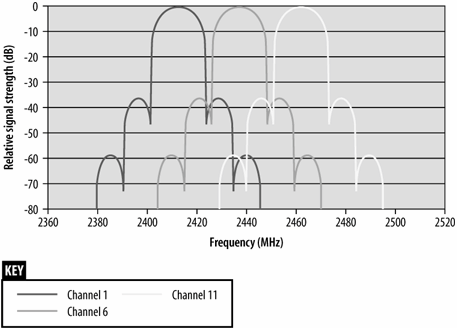
Maximum theoretical throughput
If the signal processing techniques used by the DS PHY are used, then the maximum throughput would be a function of the frequency space used. Roughly speaking, the ISM band is 80-MHz wide. Using the same spreading factor of 11 would lead to a maximum bit rate of slightly more than 7 Mbps. However, only one channel would be available, and products would need to have an oscillator running at 77 MHz to generate the chipping sequence. High-frequency devices are a tremendous drain on batteries, and the hypothetical high-rate encoding that uses the entire band makes terrible use of the available spectrum. To achieve higher throughput, more sophisticated techniques must be used. 802.11b increases the symbol rate slightly, but it gets far more mileage from more sophisticated encoding techniques.
Interference response
Direct-sequence-modulated signals are more resistant to interference than frequency-hopping signals. The correlation process enables direct-sequence systems to work around narrowband interference much more effectively. With 11 chips per bit, several chips can be lost or damaged before a single data bit is lost. The disadvantage is that the response of direct-sequence systems to noise is not incremental. Up to a certain level, the correlator can remove noise, but once interference obscures a certain amount of the frequency band, nothing can be recovered. Figure 12-8 shows how direct-sequence systems degrade in response to noise.
Figure 12-8. Throughput response to interference in DSSS systems
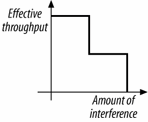
Direct-sequence systems also avoid interfering with a primary user more effectively than frequency-hopping systems. After direct-sequence processing, signals are much wider and have lower amplitudes, so they appear to be random background noise to traditional narrowband receivers. Two direct-sequence users in the same area can cause problems for each other quite easily if the two direct-sequence channels are not separated by an adequate amount. Generally speaking, interference between two direct-sequence devices is a problem long before a primary band user notices anything.
Introduction to Wireless Networking
- Introduction to Wireless Networking
- Why Wireless?
- What Makes Wireless Networks Different
- A Network by Any Other Name...
Overview of 802.11 Networks
- Overview of 802.11 Networks
- IEEE 802 Network Technology Family Tree
- 11 Nomenclature and Design
- 11 Network Operations
- Mobility Support
11 MAC Fundamentals
- 11 MAC Fundamentals
- Challenges for the MAC
- MAC Access Modes and Timing
- Contention-Based Access Using the DCF
- Fragmentation and Reassembly
- Frame Format
- Encapsulation of Higher-Layer Protocols Within 802.11
- Contention-Based Data Service
- Frame Processing and Bridging
11 Framing in Detail
- 11 Framing in Detail
- Data Frames
- Control Frames
- Management Frames
- Frame Transmission and Association and Authentication States
Wired Equivalent Privacy (WEP)
- Wired Equivalent Privacy (WEP)
- Cryptographic Background to WEP
- WEP Cryptographic Operations
- Problems with WEP
- Dynamic WEP
User Authentication with 802.1X
- User Authentication with 802.1X
- The Extensible Authentication Protocol
- EAP Methods
- 1X: Network Port Authentication
- 1X on Wireless LANs
11i: Robust Security Networks, TKIP, and CCMP
- 11i: Robust Security Networks, TKIP, and CCMP
- The Temporal Key Integrity Protocol (TKIP)
- Counter Mode with CBC-MAC (CCMP)
- Robust Security Network (RSN) Operations
Management Operations
- Management Operations
- Management Architecture
- Scanning
- Authentication
- Preauthentication
- Association
- Power Conservation
- Timer Synchronization
- Spectrum Management
Contention-Free Service with the PCF
- Contention-Free Service with the PCF
- Contention-Free Access Using the PCF
- Detailed PCF Framing
- Power Management and the PCF
Physical Layer Overview
- Physical Layer Overview
- Physical-Layer Architecture
- The Radio Link
- RF Propagation with 802.11
- RF Engineering for 802.11
The Frequency-Hopping (FH) PHY
- The Frequency-Hopping (FH) PHY
- Frequency-Hopping Transmission
- Gaussian Frequency Shift Keying (GFSK)
- FH PHY Convergence Procedure (PLCP)
- Frequency-Hopping PMD Sublayer
- Characteristics of the FH PHY
The Direct Sequence PHYs: DSSS and HR/DSSS (802.11b)
- The Direct Sequence PHYs: DSSS and HR/DSSS (802.11b)
- Direct Sequence Transmission
- Differential Phase Shift Keying (DPSK)
- The Original Direct Sequence PHY
- Complementary Code Keying
- High Rate Direct Sequence PHY
11a and 802.11j: 5-GHz OFDM PHY
- 11a and 802.11j: 5-GHz OFDM PHY
- Orthogonal Frequency Division Multiplexing (OFDM)
- OFDM as Applied by 802.11a
- OFDM PLCP
- OFDM PMD
- Characteristics of the OFDM PHY
11g: The Extended-Rate PHY (ERP)
- 11g: The Extended-Rate PHY (ERP)
- 11g Components
- ERP Physical Layer Convergence (PLCP)
- ERP Physical Medium Dependent (PMD) Layer
A Peek Ahead at 802.11n: MIMO-OFDM
11 Hardware
- 11 Hardware
- General Structure of an 802.11 Interface
- Implementation-Specific Behavior
- Reading the Specification Sheet
Using 802.11 on Windows
11 on the Macintosh
Using 802.11 on Linux
- Using 802.11 on Linux
- PCMCIA Support on Linux
- Linux Wireless Extensions and Tools
- Agere (Lucent) Orinoco
- Atheros-Based cards and MADwifi
- 1X on Linux with xsupplicant
Using 802.11 Access Points
- Using 802.11 Access Points
- General Functions of an Access Point
- Power over Ethernet (PoE)
- Selecting Access Points
- Cisco 1200 Access Point
- Apple AirPort
Logical Wireless Network Architecture
- Logical Wireless Network Architecture
- Evaluating a Logical Architecture
- Topology Examples
- Choosing Your Logical Architecture
Security Architecture
- Security Architecture
- Security Definition and Analysis
- Authentication and Access Control
- Ensuring Secrecy Through Encryption
- Selecting Security Protocols
- Rogue Access Points
Site Planning and Project Management
- Site Planning and Project Management
- Project Planning and Requirements
- Network Requirements
- Physical Layer Selection and Design
- Planning Access-Point Placement
- Using Antennas to Tailor Coverage
11 Network Analysis
11 Performance Tuning
Conclusions and Predictions
EAN: 2147483647
Pages: 179

